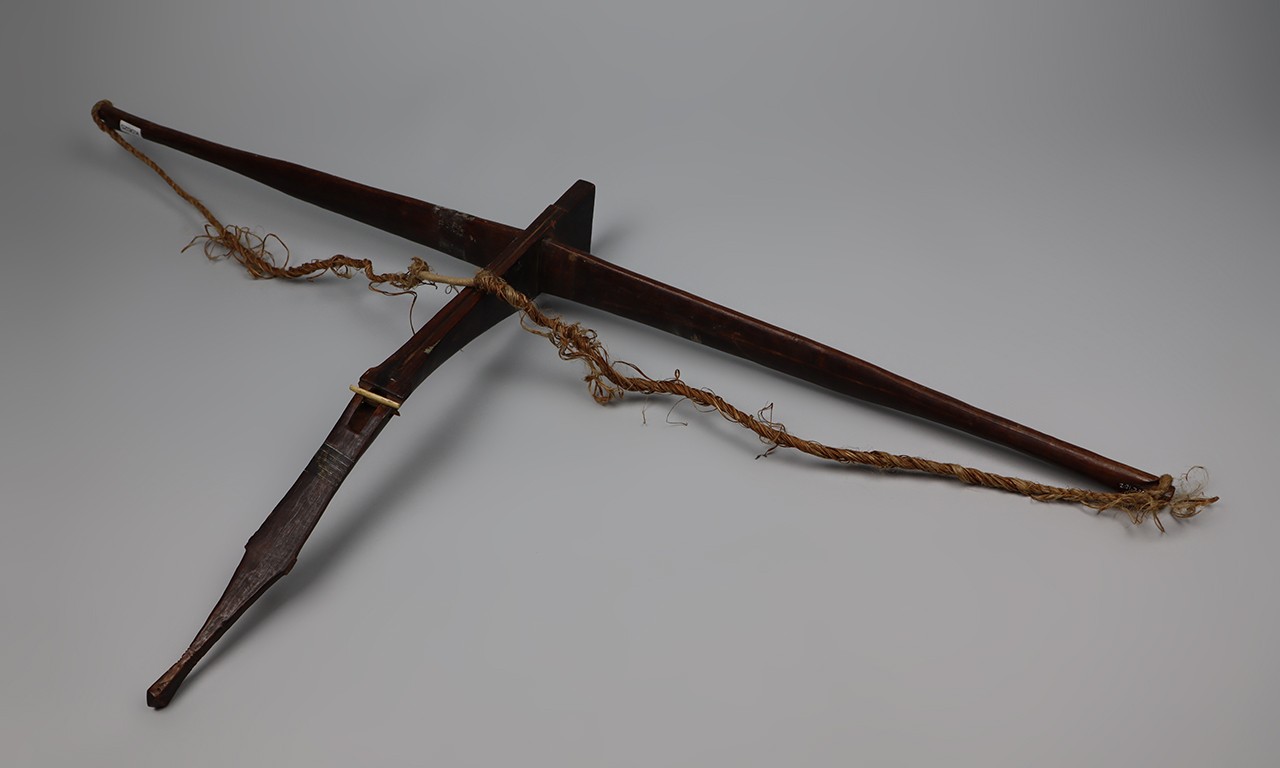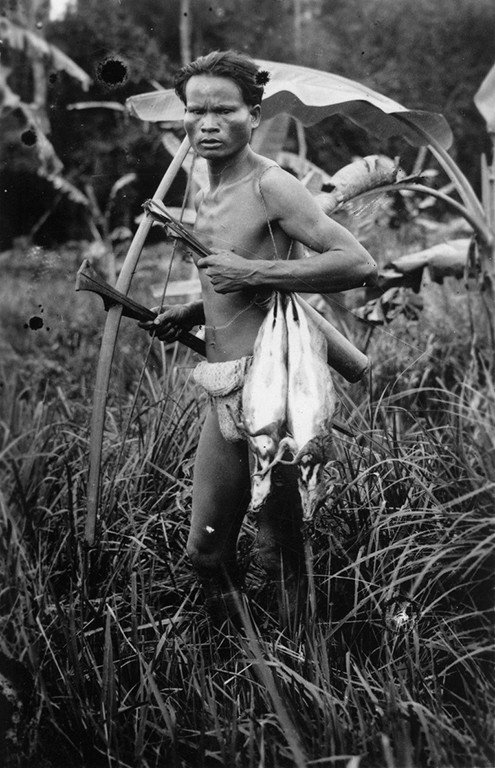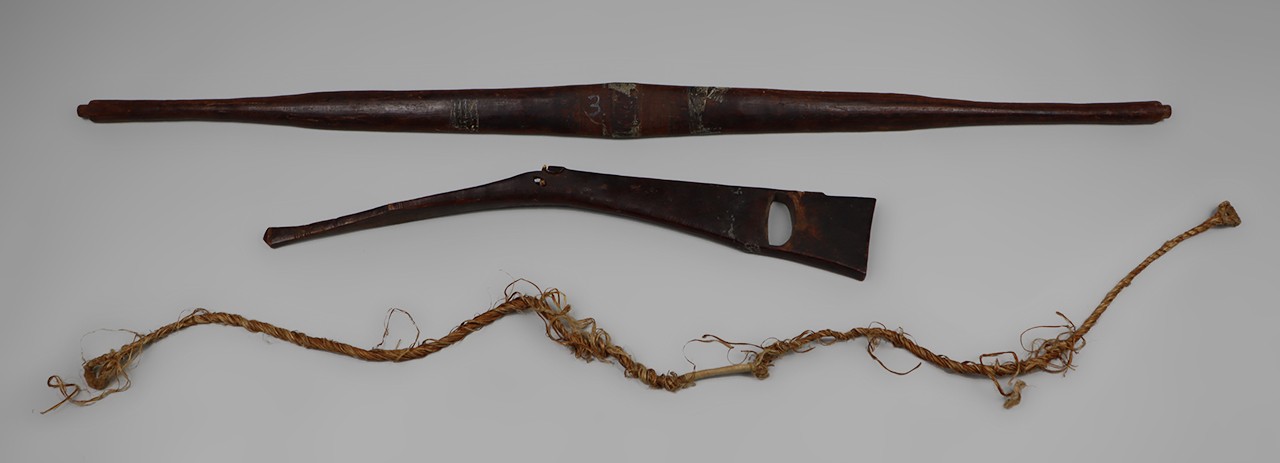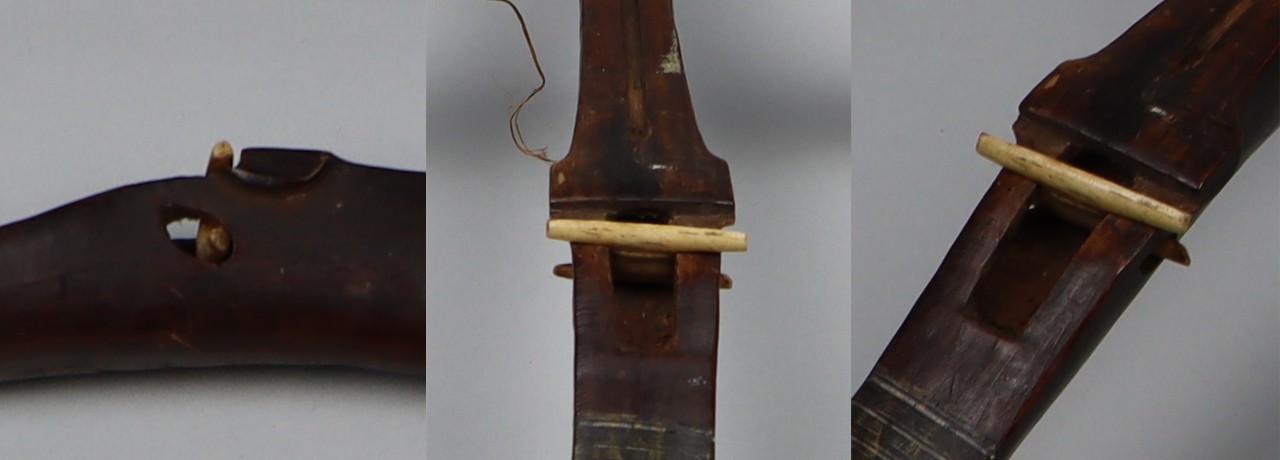 |
Crossbow, 1960s
Montagnard culture; Central Highlands region, Vietnam
Wood and bamboo fiber; 28 × 2 × 40 1/2 in.
2021.7.9a-c
Anonymous Gift |
Enemy’s Enemy
During the Vietnam War the United States and South Vietnam allied with some of the Indigenous peoples of the country’s Central Highlands. Collectively called the Montagnard peoples—a name derived from the French word for mountain-dwellers—the umbrella term refers to six main ethnic groups that historically resided in the region. With their very livelihoods on the line, many decided to train and fight with the United States Special Forces and ultimately served in great numbers in the war. The recently accessioned Montagnard crossbow featured in this post was used alongside firearms during the war as a staple weapon of Vietnam’s Central Highlands cultures.
 |
| Montagnard man holding crossbow, date unknown |
Highlanders
The Montagnard people have long suffered at the hands of others. In the 9th century they were forced to move from Vietnam’s coastal areas to the Highlands by new settlers to the region. Another effort to have them displaced came in the early 20th century when French growers discovered that highland soil was ideal for growing coffee. This same period saw the arrival of Christian missionaries and the conversion of a large percentage of the population. The proselytization of the Montagnard people changed little for the predominant Kinh culture of Vietnam who referred to the Montagnard as Moi, their word for savages. French occupiers seeking to maintain control prevented the worst actions against Highland peoples, but these protections disappeared when they were ousted from Vietnam. All of this and more fed into the willingness of the Montagnards to fight alongside the United States, though it should be noted that many Montagnard groups remained independent or opposed South Vietnam. The Montagnard people that did fight against North Vietnam were recruited and trained by American and Australian Special Forces. Valued for their excellent tracking skills and knowledge of the region, they specialized in unconventional warfare and used traditional crossbows such as this one to hold back the Viet Cong forces. Given that this piece was collected circa 1968 near the city of Pleiku in Gia Lai Province, it is possible that an individual from the Jarai culture may have made the crossbow featured in this post.

 |
Crossbow Bolts with Quiver, 1960s
Montagnard culture; Central Highlands region, Vietnam
Bamboo and plant fiber; 16 × 3/4 × 1 in. (arrows in quiver)
2021.7.10.1-.6
Anonymous Gift |
The Aftermath of War
It is estimated that at the beginning of the 1960s as many as a million Montagnards lived in the Central Highlands of Vietnam. Of them, some 40,000 fought alongside the United States. By the end of the war around 200,000 Montagnards had been killed by both sides. Up to 85% of their villages had been burnt to a cinder. Their lands were hit harder with chemicals like Agent Orange and napalm than just about any other part of Vietnam. Those that remained in Vietnam suffered additional persecution and prejudice. Many were driven from their land and made refugees, and some were relocated to the US, primarily North Carolina. Although their population was severely damaged by the war, their numbers have quadrupled since the 1960s and many Indigenous and American Montagnards are continually advocating to restore their lands and autonomy.
 |
2021.7.9a-c disassembled
Anonymous Gift |
Silent and Deadly
The design of Montagnard crossbows makes them effective at launching lightweight bamboo bolts at high speed. Their two primary components are a stock and a lath (bow) made of sturdy dark wood. The lath sockets into a hole in the thicker end of the stock. There is still some evidence of the fiber wrap that would have held the lath in place. A drawstring made of bamboo fibers is attached to the lath by recessed knobs at its ends. To fire the weapon, the drawstring is pulled back to rest on a catch, poison-tipped bolts with shafts and fletching made of bamboo are taken from bamboo quivers and set in the quarrel groove, and then the firing mechanism is triggered. The bolts are lightweight enough that they essentially function only as delivery systems for poison. They can be fired silently, which madethem ideal for the asymmetric combat of the Vietnam War.
 |
Side, top, and angled views of the firing mechanism on 2021.7.9a-c
Anonymous Gift |
Simplicity of Design
Several types of firing mechanisms are employed in Montagnard crossbows. Perhaps the most common involves the stock being hollowed out vertically just behind the quarrel groove and a lever inserted. A bar-shaped catch at the top of the lever harnesses the tension of the drawstring against the side of the lever to hold it in place. The other end of the lever protrudes from the bottom of the stock and works as a trigger. When it is pulled back, the catch angles so that it releases the drawstring. As the drawstring snaps toward the lath, it catches the rear of the bolt and launches it. The firing mechanism seen here is relatively unique. Instead of featuring a vertical lever which passes through the stock, it instead has an I-shaped catch made of bone that is socketed into a cavity in the same part of the stock. The lower bar of the I-shaped catch protrudes from the side of the stock on both sides. With the bowstring holding the catch tight, a user could pull the lower bar of the I-shaped catch towards them, again angling the catch to release the drawstring and loose a bolt.
Text and images may be under copyright. Please contact Collection Department for permission to use. References are available on request. Information subject to change upon further research.







Comments